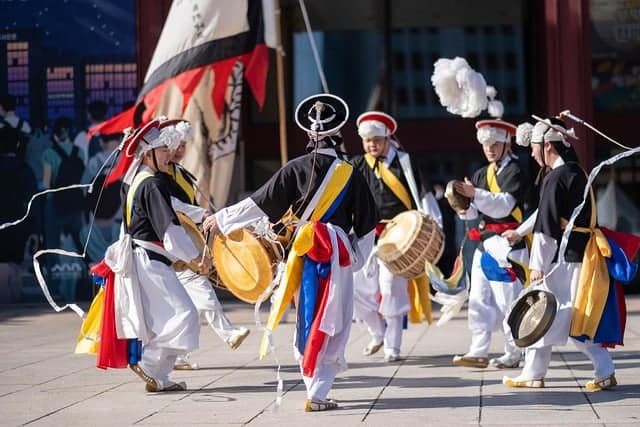Samulnori is a representative traditional Korean percussion performance.
It showcases diverse rhythms and dynamic performances using four instruments: kkwaenggwari, jing, janggu, and buk.
Characteristics of Samulnori
- Four Instruments:
- Kkwaenggwari: Symbolizing lightning, it leads the performance with the highest pitch.
- Jing: Symbolizing wind, it creates overall harmony with its deep and resonant sound.
- Janggu: Symbolizing rain, it creates various rhythms and melodies.
- Buk: Symbolizing clouds, it provides a central grounding with its heavy and powerful sound.
- Dynamic Performance: Samulnori is divided into “jwaban” (seated performance) and “ipban” (standing and moving performance), showcasing diverse melodies with dynamic movements.
- Improvisation and Diversity: Samulnori consists of improvisational performances by the players and combinations of various melodies without a fixed musical score. There are diverse melodies and performance styles in each region.
Regions Where You Can Watch Samulnori
- Namsangol Hanok Village in Seoul: You can enjoy Samulnori performances amidst traditional houses and beautiful nature.
- Korean Folk Village: You can watch Samulnori performances along with other traditional performances.
- Regional Festivals: You can experience Samulnori performances at various festivals held in each region.
- National Gugak Center: The National Gugak Center hosts various Korean traditional music performances, including frequent Samulnori performances.
- Insadong: Insadong is a street of traditional culture, where you can experience various traditional performances, including Samulnori, in traditional tea houses, restaurants, and performance venues.
You can check Samulnori performance information through the websites of the respective organizations or festivals, or purchase tickets from online ticketing sites.
Here are some of the leading Samulnori teams in Korea:
Samulnori:
- Founded in 1978, the Samulnori team started with four founding members: Kim Duk-soo, Kim Yong-bae, Lee Kwang-soo, and Choi Jong-sil.
- They developed traditional Nongak melodies into a stage art, pioneering a new genre called Samulnori.
- The Samulnori team has been actively performing both domestically and internationally, promoting the excellence of Korean traditional music to the world.
Samulnori Hanullim Art Troupe:
- Founded in 1993, it is based on Kim Duk-soo’s Samulnori style.
- They are dedicated to modernizing and popularizing traditional music, engaging in various creative activities.
- They spread the beauty of Korean traditional music through diverse performances both domestically and internationally.
Traditional Performing Arts Group TATU:
- Based on traditional culture and arts, they create contemporary performances that communicate with the modern era.
- They plan various performances based on Korean traditional arts such as Samulnori, lion dance, and Pansori, maintaining the depth of traditional arts while connecting with audiences through modern expressions.
Korean Traditional Music Performance Group Jingsori:
- Based in Chungju, this Samulnori team promotes Samulnori through local festivals and various events.
- In addition to these, various Samulnori teams across the country are actively contributing to the development of Korean traditional music.
